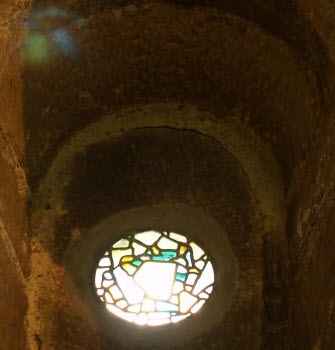Short History of Stained Glass
It has yet to be determined where glass first appeared. The production of glass dates back millennia; however, the technique of glass blowing is a more modern development that dates back to around 50 BC Glass artisans may do the shape and coloring of glass in various ways. Hundreds of historical glass artifacts have been preserved, allowing us to compare and contrast ancient and modern glassmaking methods. Even if they could be in better shape, the few sites dedicated to the ancient art of glassmaking nonetheless are fascinating.
Somewhere in the 4th century, as Christians began constructing churches, stained glass became widely recognized as a type of Christian art. Stained glass became the preeminent form of artistic expression in the new century because of its close connection to the propagation of Christianity over Europe, leading to the proliferation of stained glass across the globe.
The St. Paul’s Monastery in Jarrow, England (photo below), established in 686 AD, is credited with housing one of the oldest examples of numerous pieces of tinted glass used to construct a window. Five quite complex sculptures in the Augsburg Cathedral are claimed to be the most aged intact European windows.

 Arab architects gained recognition in the Middle East in the eighth century and were touted to be responsible for the production of stained glass. In Kitab al-Durra al-Maknuna, the Iranian chemist Jabir ibn Hayyan provided 46 unique formulas for creating colored glass (The Book of the Hidden Pearl).
Arab architects gained recognition in the Middle East in the eighth century and were touted to be responsible for the production of stained glass. In Kitab al-Durra al-Maknuna, the Iranian chemist Jabir ibn Hayyan provided 46 unique formulas for creating colored glass (The Book of the Hidden Pearl).
Hugh Tait, in his book Glass 5,000 Years (1991), explains how colored glass was made in antiquity, but he does not give any sources to back up this knowledge, so I am hesitant to believe that he has concrete proof:
Coloured glass was made by the addition of specific metal oxides and by varying the furnace conditions. For example, in antiquity copper produced turquoise or pale blue, dark green, ruby red or opaque dark red, while the addition of cobalt resulted in a deep blue; manganese was required for yellowish or purple glass, antimony for opaque yellow (or pale orange) and opaque white, and iron for pale blue, bottle green, amber or a dark color appearing black… Almost colourless glass could be achieved by the careful selection of fine silver free sand, but manganese and, it seems, above all antimony, the most effective agent, were used as decolourants. (Tait, 21)
There are no exact formulas to obtain certain colors. There might be suggested amounts, but every batch is different. Changing the color of the glass is like cooking: everyone can follow a recipe, but true talent comes through when the artisan steps away from the norms and is willing to experiment. Today we have a glass recipe dated between the 4th and 12th centuries BC, preserved on a clay tablet from Mesopotamia. One of the most intriguing aspects of this tablet is that it gives instructions on how to add lead, copper, and antimony in differing proportions to batches of raw glass; presumably, ancient artisans used this to change the color of the glass.
Once you learn a little about the making of glass you begin to see all of the seemingly limitless possibilities of what can be formed; and hope that by mastering it, you can bring out all of the attributes that are hidden within yourself. People have been fascinated by this for centuries. The thought of having a highly prized skill that would allow you to go where the wind blew you is a dream to me. So many aspects of glass-blowing appeal to me, but when I read that the artists get to pick up and leave when they get the urge, it reaffirmed the thought that I must learn glass-blowing. The mystique of a glass blower’s life is very enticing; I would like to be dexterous, creative, and spontaneous, and with all of these skills, be able to make glass artwork that might survive for centuries. The dualistic nature of glass is enticing because it mirrors all the different facets of human nature.
By melting together some very abundant and usually extremely accessible materials like sand, ashes (alkali)- traditionally made by burning seaweed or other organic substances, and lime from crushed stone, an amazing product was formed that changed the course of technological history. (Zerwick, 8) No one person is credited with the discovery of glass blowing. Still, this invention has had enormous, far-reaching consequences because it drastically reduced the time necessary to produce glass objects. Glass is a very seductive material; today, we see it everywhere we look; it is used in many different aspects of our lives. Yet every once in a while, if you take the time to stop and look at a magnificently blown piece of glass, you can see the unbelievable beauty that can be captured in a molten liquid.
References:
Tait, Hugh. Glass 5,000 Years. New York: Harry N Abrams Inc., 1991
Zerwick, Chloe. A Short History of Glass. New York: Corning, 1980

